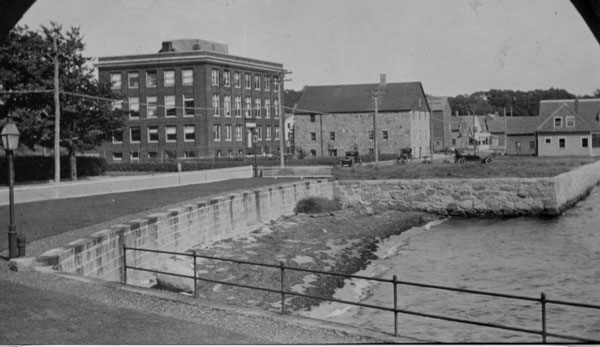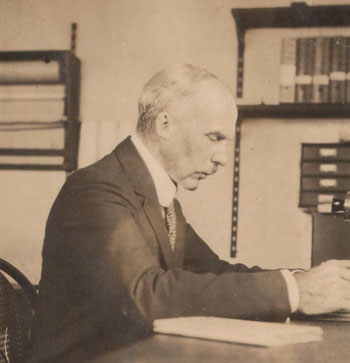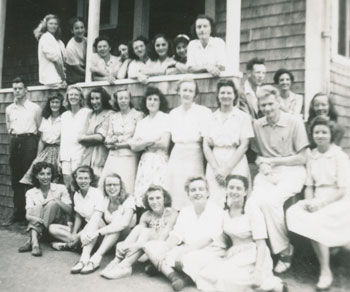Resiliency and Resolve: Impacts of Past World Events on MBL Research and Training

Thanks to the collaboration and cooperation of our entire staff, the MBL has rapidly implemented important steps in the battle against COVID-19. The attention and planning that each of you has paid to your specific responsibilities—whether they be in research, facilities, or administration—and your adaptation to change has been remarkable. While some of our most challenging days may lie ahead, together we will continue to advance the science and education that are so fundamental to the MBL mission.
The Marine Biological Laboratory has deeply felt the impact of historic events on several occasions since its founding in 1888. The World Wars, the Great Depression, and this year's COVID-19 pandemic have all called upon the MBL community to adapt, be resilient, and find new and resourceful ways to maintain the lab's mission of scientific research and education.
In some ways, the COVID-19 pandemic's impacts on MBL are unprecedented. In alignment with public health measures to prevent the spread of the virus, including travel restrictions and social distancing, for the first time in history the MBL has cancelled its spring/early summer educational programs and postponed the start of summer Whitman Center research. The cancellations include nine Advanced Research Training courses, some of which have been offered continuously for more than a century. Since mid-March, MBL employees have been working remotely except for limited, on-campus staffing needed for critical operations in research and animal care, facilities support, and security. There are no parallels for this in MBL history.
Yet the MBL's esprit de corps in facing past historic disruptions can offer insight and encouragement for the present day.
 Looking east down Water Street: Crane Building, Candle House and the MBL Club in 1919.
Looking east down Water Street: Crane Building, Candle House and the MBL Club in 1919.The 1918 influenza ("Spanish Flu") pandemic was the most severe contagion in recent history, claiming the lives of 550,000 Americans and 40 million people worldwide. The novel flu was first identified in the spring of 1918, but social distancing measures weren't adopted by U.S. cities until the pandemic's second and third waves (September to December 1918 and January to April 1919). As the MBL was then a summer-only institution, it wasn't affected when cities closed schools and banned public gatherings for up to ten weeks during those periods. The MBL's summer courses and research programs were offered as usual in 1919 and were oversubscribed, with "an influx of students and investigators that carried the attendance beyond the previous high water mark," MBL Director Frank R. Lillie wrote in the lab's Annual Report. While it may or may not have factored into the robust attendance at MBL that year, U.S. cities that adopted social distancing measures early and for sustained periods were able to mitigate mortality rates and other consequences of this historic pandemic.
 Frank R. Lillie of the University of Chicago directed the MBL from 1908-1925.
Frank R. Lillie of the University of Chicago directed the MBL from 1908-1925.The influenza pandemic coincided with World War I (1914-1918), during which attendance dropped significantly in the MBL's summer courses and research programs. "The greatest proportional loss was among the younger investigators, whose numbers were reduced to less than one half. This is explained by the fact that the young men were serving our country in various technical capacities," Lillie wrote in the 1918 Annual Report. "The conclusion of war nevertheless finds us in a strong position, with our organization intact, and no actual suspension of our work incurred in spite of a considerable diminution of it," he wrote. "The Laboratory has come through a period of serious uncertainty without harm."
Effects of The Great Depression (1929-1939) are noted in the 1932 MBL Annual Report. "For the first time since the World War, there was a sharp drop in registration of investigators," MBL Director Merkel H. Jacobs wrote. "This falling off in attendance is to be attributed chiefly, if not wholly, to unfavorable financial conditions existing in most American universities… which became especially serious in 1932." Student registrations dipped in 1933, but attendance then rose until the advent of World War II.
World War II (1939-1945) had profound impacts on the MBL, as it did on research universities and institutions nationwide. Prior to WWII, almost all federally funded research was carried out by government employees in small government labs and stations. But with the creation of the National Research Defense Council In 1940, large numbers of academic researchers were mobilized to work on wartime research and development projects, typically at their own universities. Thus, many investigators who would have come to the MBL for summer research remained at their home institutions to carry out federal projects. "In many cases this research is in their chosen field, so their time is by no means lost," wrote MBL Director Charles Packard in the 1942 Annual Report. "Indeed, in some instances it has already opened up new fields for future exploration."
 MBL Embryology Course participants in 1945.
MBL Embryology Course participants in 1945.By 1943, several MBL investigators were conducting research directly connected with the war, though most continued their peacetime investigations. The MBL also began providing laboratory space to scientists from Woods Hole Oceanographic Institution to conduct war research. Still, the number of investigators at MBL that year was a third of the pre-war attendance.
Student enrollment also dropped sharply during the early war years, as men entered military service or continued their studies at home. "Many are prevented from coming to Woods Hole by the rubber and gas shortage," Packard reported in 1941. Women continued to register; nearly 85 percent of the students at the Lab in 1943 were female. By 1944, attendance had rebounded and the courses were fully subscribed.
Despite the hardships of the war years, the MBL proved remarkably resilient. Research plans shifted; the courses continued; even the Friday Evening Lectures were held without interruption. As Packard noted in 1941, "We are faced with a marked decrease in attendance, a very considerable loss in income, and with the difficulty of obtaining supplies for research and for the upkeep of our buildings. But the fine spirit shown by our workers, both investigators and members of the permanent staff, is ample evidence that the Laboratory can adapt itself to its altered environment, and will continue to serve the cause of biological research and instruction."
Today, as the MBL adapts to public health measures driven by the historic COVID-19 pandemic, it draws upon an institutional identity shaped by perseverance and dedication to the Lab’s mission in even the most challenging times.
References
(1) Howard Markel et al (2007) Nonpharmaceutical interventions implemented by US cities during the 1918-1919 influenza pandemic. JAMA, DOI: 10.1001/jama.298.6.644.
(2) Richard Hatchett et al (2007) Public health interventions and epidemic intensity during the 1918 influenza pandemic. PNAS, DOI: 10.1073/pnas.0610941104
(3) Annual Report of the Marine Biological Laboratory for the years 1918, 1919, 1932, 1933, 1934, 1940-1944. Available online at MBL History Archives, MBLWHOI Library; also at History of Marine Biological Laboratory site.
(4) Richard Atkinson and William Blanpied (2008) Research universities: Core of the U.S. science and technology system. Technology in Society, DOI: 10.1016/j.techsoc.2007.10.004
(5) "The Evolution and Impact of Federal Government Support for R&D in Broad Outline," Supplement 1 in Allocating Federal Funds for Science and Technology (Washington, D.C., The National Academies Press, 1995). DOI: 10.17226/5040
(6) Maienschein, Jane. 100 Years Exploring Life, 1888-1988: The Marine Biological Laboratory at Woods Hole (Boston: Jones and Bartlett Publishers, 1989).DOI: 10.5962/bhl.title.14377. Available online at Biodiversity Heritage Library.
Photo credits/links:
Featured photo: View of the MBL circa 1915: History of the MBL Archives
The Crane, Candle House and MBL Club Buildings, 1919 (Credit Alfred Huettner): History of the MBL Archives, https://hdl.handle.net/1912/21016
Frank R. Lillie: History of the MBL Archives, http://hdl.handle.net/10776/2412
1945 Embryology Class: History of the MBL Archives, https://hdl.handle.net/1912/19773
Thanks to the MBLWHOI Library for research assistance.